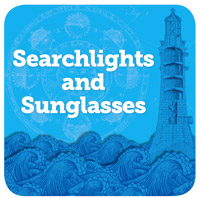
The journalism student’s view: 5 reasons why new digital book should be required reading
This week at the annual JEA/NSPA National High School Journalism Convention, Knight’s Eric Newton will be demoing his new digital book and teaching tool “Searchlights and Sunglasses.” The text explores journalism’s digital transformation, and then, with one click provides more than 1,000 lesson plan ideas and resources for educators. (For those attending the conference, the talk begins at 10 a.m. Saturday in the Clarendon room.)

Below, as part of a blog series, journalism student Romina Herrera writes about the parts of “Searchlights and Sunglasses” that most resonate with her.
I was 12-years-old when the first computer arrived in our home: it had a beige exterior, no mouse, and a black screen displaying text in bright green. Our second computer was a major improvement: it came with Windows 95 and a device that dialed a phone number, made a weird little noise, and with luck, connected us to the outside world via the Internet.
That was almost two decades ago. Now everyone in my family owns at least two devices that keep them online at all times. To my parents, I am a “Digital Native.” But after seeing how some people younger than me use technology, I start to worry how long it will be until I won’t be able to keep up. RELATED LINKS
Continue the conversation with #edshift and at edshift.org.
“Pencils down everyone. Your digital toolbox is here’: Five lessons from ‘Searchlight and Sunglasses” on KnightBlog
“Getting students to ask tough questions: My 5 favorite parts of “Searchlights and Sunglasses” on KnightBlog
“Navigating Knight’s new digital book: Choose your own adventure” on KnightBlog
This dilemma, to find the perfect balance between old-school knowledge that is still relevant and need-to-know digital skills, is deeply affecting journalism education. Lightning fast advances in technology are changing the very fabric of our culture and our social interactions. Somewhere along this path, newspapers have shrunk, the line between producers and consumers is blurring, and some schools are struggling with how to best prepare a new generation of journalists.
As a student at FIU’s School of Journalism and Mass Communications, I have ended up getting my hands more “digitally dirty” than those in other majors. This past summer I had the opportunity to work as an intern for Knight Foundation, where I became part of Eric Newton’s team to complete the book “Searchlights and Sunglasses: Footnotes from the Digital Age of Journalism.” It made me wish I could have seen its contents earlier.
In a time when communications degrees keep appearing in lists of “worst college majors,” “Searchlight and Sunglasses” explains what we need to do more of to move up in the ranks.
Here are five reasons why the book is awesome:
1. It’s really two books in one. The main part of the book is a collection of Newton’s insights about the world of journalism, foundations, education and communities. Collected from several years of blogging for Knight Foundation, the essays contain a wealth of information and examples about what journalism is doing right (and what it is doing wrong).
The other part of the book is the Learning Layer. Appearing as strategically placed red buttons besides the main content, these bubbles expand on topics discussed in the text and provide assignments and activities for teachers and students to get their hands dirty. In a traditional sense, this would be the “workbook” companion.
2. It’s got more resources than you can shake a stick at. The team really went above and beyond to provide useful links to major journalism and education reports, digital tools, resource websites, articles, books and linking back to the source for almost any significant piece of information that is mentioned in the text, even more so in the Learning Layer. That’s over 1,000 links to more valuable information. I spent all summer exploring (almost) everything that was linked within it. Trust me, it’s a lot of stuff.
3. It doesn’t have all the answers, but it has plenty of solutions. I have to admit that prior to reading Newton’s essays, I had a very pessimistic outlook on the future of news. Being exposed to the new research, and projects being carried out by schools and students made me realize that there’s still plenty of ways to fix parts of the system that appear broken.
4. It predicts the future. Is journalism a field that only concerns itself with events that have already passed? Maybe in a purely traditional sense. But if you take all that knowledge and start analyzing the trends, you can start painting a picture of the future. Newton does this in several parts of the book and he’s not afraid to get far-fetched with his predictions.
5. It’s pretty. Since its digital, the book gets a little fancy with its design. Each chapter has a gorgeous header image, the content flows in smooth scrolling motions and there are plenty of photo slideshows, animated graphs and even some goodies hidden within some of the graphics. Don’t we all like to read something that’s also nice to look at?
I can’t wait to see how other students and teachers will receive this project. I hope it can be the searchlight that provides direction for those that are still confused about journalism’s role in the digital era.
Romina Herrera is a journalism student at Florida International University.
Recent Content
-
Journalismarticle ·
-
Journalismarticle ·
-
Journalismarticle ·



